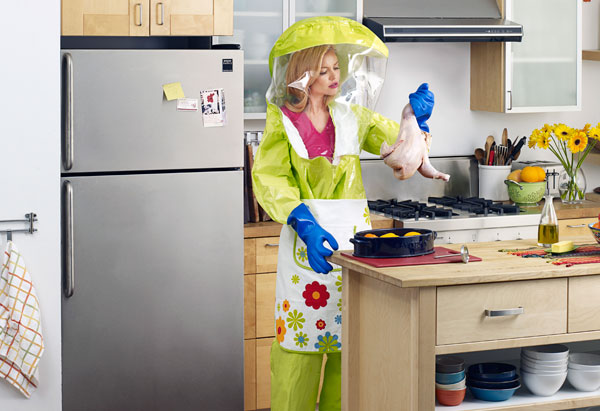Could Your Kitchen Pass a Health Inspection?
A germ-slaying, food-saving cheat sheet for protecting your home from everyday pathogens.

Photo: Levi Brown
We're not sure which is more startling: that an estimated 76 million cases of foodborne illness occur in the United States every year, or that up to 80 percent of them are believed to be caused by food prepared at home. When it comes to restaurants, public health officials try to keep those numbers in check with regular safety inspections. But who's checking up on you?
The following food-handling guidelines come from the United States Department of Agriculture and the National Restaurant Association. From your fridge temp to your fruit-washing routine, they'll help you keep your kitchen up to code.
Set the right temperature.
Always keep your fridge between 32 and 40 degrees. Any warmer and you're entering what food-safety experts call the danger zone, in which bacteria can multiply to harmful levels within a few hours. If your fridge doesn't have a built-in temperature gauge, pick up an appliance thermometer for a few dollars.
Thaw smart.
Freezing doesn't kill pathogens; they begin to regrow as soon as food returns to room temperature. So never thaw frozen foods out on the counter where they could sit for hours in the "danger zone." Use the defrost setting on your microwave if you're ready to cook immediately; otherwise, thaw foods in the fridge.
Know what "use by" means.
This label usually indicates the last day for "peak quality"; it's set by the manufacturer and is not a safety recommendation. Food should remain good beyond this date if refrigerated below 40 degrees. In general, uncooked poultry and ground meats are safe for up to two days past the date, steaks and chops for up to five days, and eggs for up to five weeks.
Wash all produce.
You might not think foods like pineapple or cantaloupe need to be rinsed; after all, you don't eat the skins. But a knife blade can carry bacteria from rind to flesh, so wash all produce under cold tap water, ideally scrubbing with a brush (the friction removes pesticide residue). Also, cut away bruised or damaged areas; bacteria thrive there.
Fight sponge scuzz.
Disinfect once a week, either by zapping them in the microwave for one minute or running them through the dishwasher for a full cycle. Always clean sponges immediately after wiping up raw meat or poultry.
Don't leave food out.
Throw away anything perishable that's been sitting out for more than two hours.
Wash hands after handling chicken.
Although we all know this one already, a recent Kansas State University video surveillance study found that 50 percent of the adults observed did not properly wash their hands after touching raw poultry (although 90 percent of them claimed to do so). The USDA recommends always washing with warm water and soap for 20 seconds before and after handling food.
But don't wash the chicken itself.
If you try to fight germs by rinsing raw meat before cooking, you're only spreading bacteria around your kitchen. Simply cooking meat thoroughly will eliminate pathogens.
Next: The exact temperatures you'll need to keep meat safe to consume
The following food-handling guidelines come from the United States Department of Agriculture and the National Restaurant Association. From your fridge temp to your fruit-washing routine, they'll help you keep your kitchen up to code.
Refrigerator
Set the right temperature.
Always keep your fridge between 32 and 40 degrees. Any warmer and you're entering what food-safety experts call the danger zone, in which bacteria can multiply to harmful levels within a few hours. If your fridge doesn't have a built-in temperature gauge, pick up an appliance thermometer for a few dollars.
Thaw smart.
Freezing doesn't kill pathogens; they begin to regrow as soon as food returns to room temperature. So never thaw frozen foods out on the counter where they could sit for hours in the "danger zone." Use the defrost setting on your microwave if you're ready to cook immediately; otherwise, thaw foods in the fridge.
Know what "use by" means.
This label usually indicates the last day for "peak quality"; it's set by the manufacturer and is not a safety recommendation. Food should remain good beyond this date if refrigerated below 40 degrees. In general, uncooked poultry and ground meats are safe for up to two days past the date, steaks and chops for up to five days, and eggs for up to five weeks.
Counter and Sink
Wash all produce.
You might not think foods like pineapple or cantaloupe need to be rinsed; after all, you don't eat the skins. But a knife blade can carry bacteria from rind to flesh, so wash all produce under cold tap water, ideally scrubbing with a brush (the friction removes pesticide residue). Also, cut away bruised or damaged areas; bacteria thrive there.
Fight sponge scuzz.
Disinfect once a week, either by zapping them in the microwave for one minute or running them through the dishwasher for a full cycle. Always clean sponges immediately after wiping up raw meat or poultry.
Don't leave food out.
Throw away anything perishable that's been sitting out for more than two hours.
Wash hands after handling chicken.
Although we all know this one already, a recent Kansas State University video surveillance study found that 50 percent of the adults observed did not properly wash their hands after touching raw poultry (although 90 percent of them claimed to do so). The USDA recommends always washing with warm water and soap for 20 seconds before and after handling food.
But don't wash the chicken itself.
If you try to fight germs by rinsing raw meat before cooking, you're only spreading bacteria around your kitchen. Simply cooking meat thoroughly will eliminate pathogens.
Next: The exact temperatures you'll need to keep meat safe to consume



